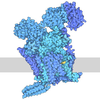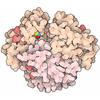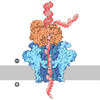[English] 日本語
 Yorodumi
Yorodumi- EMDB-50438: Cryo-EM Structure of Amyloid-beta Fibrils Carrying the Uppsala Ab... -
+ Open data
Open data
- Basic information
Basic information
| Entry |  | |||||||||
|---|---|---|---|---|---|---|---|---|---|---|
| Title | Cryo-EM Structure of Amyloid-beta Fibrils Carrying the Uppsala AbetaUpp(1-42)delta(19-24) Mutation - Polymorph 2 | |||||||||
 Map data Map data | primary map | |||||||||
 Sample Sample |
| |||||||||
 Keywords Keywords | Amyloid Fibril / PROTEIN FIBRIL | |||||||||
| Function / homology |  Function and homology information Function and homology informationamyloid-beta complex / growth cone lamellipodium / cellular response to norepinephrine stimulus / growth cone filopodium / microglia development / collateral sprouting in absence of injury / Formyl peptide receptors bind formyl peptides and many other ligands / axo-dendritic transport / regulation of Wnt signaling pathway / regulation of synapse structure or activity ...amyloid-beta complex / growth cone lamellipodium / cellular response to norepinephrine stimulus / growth cone filopodium / microglia development / collateral sprouting in absence of injury / Formyl peptide receptors bind formyl peptides and many other ligands / axo-dendritic transport / regulation of Wnt signaling pathway / regulation of synapse structure or activity / axon midline choice point recognition / astrocyte activation involved in immune response / NMDA selective glutamate receptor signaling pathway / regulation of spontaneous synaptic transmission / mating behavior / growth factor receptor binding / peptidase activator activity / Golgi-associated vesicle / PTB domain binding / positive regulation of amyloid fibril formation / Insertion of tail-anchored proteins into the endoplasmic reticulum membrane / astrocyte projection / Lysosome Vesicle Biogenesis / neuron remodeling / Deregulated CDK5 triggers multiple neurodegenerative pathways in Alzheimer's disease models / nuclear envelope lumen / dendrite development / positive regulation of protein metabolic process / TRAF6 mediated NF-kB activation / signaling receptor activator activity / Advanced glycosylation endproduct receptor signaling / negative regulation of long-term synaptic potentiation / modulation of excitatory postsynaptic potential / The NLRP3 inflammasome / main axon / transition metal ion binding / intracellular copper ion homeostasis / regulation of multicellular organism growth / ECM proteoglycans / regulation of presynapse assembly / positive regulation of T cell migration / neuronal dense core vesicle / Purinergic signaling in leishmaniasis infection / positive regulation of chemokine production / cellular response to manganese ion / Notch signaling pathway / clathrin-coated pit / extracellular matrix organization / neuron projection maintenance / astrocyte activation / ionotropic glutamate receptor signaling pathway / Mitochondrial protein degradation / positive regulation of calcium-mediated signaling / positive regulation of mitotic cell cycle / axonogenesis / protein serine/threonine kinase binding / response to interleukin-1 / platelet alpha granule lumen / cellular response to copper ion / cellular response to cAMP / positive regulation of glycolytic process / central nervous system development / positive regulation of interleukin-1 beta production / dendritic shaft / endosome lumen / trans-Golgi network membrane / positive regulation of long-term synaptic potentiation / adult locomotory behavior / learning / positive regulation of JNK cascade / Post-translational protein phosphorylation / locomotory behavior / serine-type endopeptidase inhibitor activity / microglial cell activation / positive regulation of non-canonical NF-kappaB signal transduction / TAK1-dependent IKK and NF-kappa-B activation / cellular response to nerve growth factor stimulus / regulation of long-term neuronal synaptic plasticity / recycling endosome / synapse organization / visual learning / response to lead ion / positive regulation of interleukin-6 production / Golgi lumen / cognition / Regulation of Insulin-like Growth Factor (IGF) transport and uptake by Insulin-like Growth Factor Binding Proteins (IGFBPs) / endocytosis / cellular response to amyloid-beta / neuron projection development / positive regulation of inflammatory response / positive regulation of tumor necrosis factor production / Platelet degranulation / heparin binding / regulation of translation / regulation of gene expression / early endosome membrane / G alpha (i) signalling events / perikaryon / G alpha (q) signalling events / dendritic spine Similarity search - Function | |||||||||
| Biological species | unidentified (others) /  Homo sapiens (human) Homo sapiens (human) | |||||||||
| Method | helical reconstruction / cryo EM / Resolution: 3.9 Å | |||||||||
 Authors Authors | Zielinski M / Peralta Reyes FS / Gremer L / Pagnon de la Vega M / Roeder C / Heidler TV / Syvaenen S / Willbold D / Sehlin D / Ingelsson M / Schroeder GF | |||||||||
| Funding support |  Germany, 1 items Germany, 1 items
| |||||||||
 Citation Citation |  Journal: Acta Neuropathol Commun / Year: 2025 Journal: Acta Neuropathol Commun / Year: 2025Title: Cryo-EM studies of amyloid-β fibrils from human and murine brains carrying the Uppsala APP mutation (Δ690-695). Authors: Mara Zielinski / Fernanda S Peralta Reyes / Lothar Gremer / Simon Sommerhage / María Pagnon de la Vega / Christine Röder / Thomas V Heidler / Stina Syvänen / Dieter Willbold / Dag Sehlin ...Authors: Mara Zielinski / Fernanda S Peralta Reyes / Lothar Gremer / Simon Sommerhage / María Pagnon de la Vega / Christine Röder / Thomas V Heidler / Stina Syvänen / Dieter Willbold / Dag Sehlin / Martin Ingelsson / Gunnar F Schröder /    Abstract: Today, 13 intra-amyloid-β (Aβ) amyloid precursor protein (APP) gene mutations are known to cause familial Alzheimer's disease (AD). Most of them are point mutations causing an increased production ...Today, 13 intra-amyloid-β (Aβ) amyloid precursor protein (APP) gene mutations are known to cause familial Alzheimer's disease (AD). Most of them are point mutations causing an increased production or a change in the conformation of Aβ. The Uppsala APP mutation (Δ690-695 in APP, Δ19-24 in Aβ) is the first known multi-codon deletion causing autosomal dominant AD. Here, we applied cryo-electron microscopy (cryo-EM) to investigate the structure of Aβ fibrils with the Uppsala APP mutation from tg-UppSwe mouse brain tissue. Murine AβUpp(1-42) are made of two identical S-shaped protofilaments with an ordered fibril core of S8-A42. The murine Aβ fold is almost identical to previously described human type II filaments, although the amino acid sequences differ considerably. In addition, we report the cryo-EM structure of Aβ fibrils from the temporal cortex of a patient with the Uppsala APP mutation. The observed structure of the human Aβ fold closely resembles previously described type I fibrils. Structural modeling suggests that these fibrils are composed of wild-type Aβ, which implies that AβUpp may be less soluble and thus not readily accessible for cryo-EM image processing and structure determination. Additionally, from the human sample we determined the structures of tau paired helical filaments and tau straight filaments, which are identical to those found in sporadic AD cases. Finally, we present the 3D cryo-EM structures of four dominant AβUpp(1-42) fibril polymorphs, formed in vitro. All four polymorphs differ from the observed folds of Uppsala Aβ in murine and human brain tissue, respectively. | |||||||||
| History |
|
- Structure visualization
Structure visualization
| Supplemental images |
|---|
- Downloads & links
Downloads & links
-EMDB archive
| Map data |  emd_50438.map.gz emd_50438.map.gz | 28.1 MB |  EMDB map data format EMDB map data format | |
|---|---|---|---|---|
| Header (meta data) |  emd-50438-v30.xml emd-50438-v30.xml emd-50438.xml emd-50438.xml | 17.5 KB 17.5 KB | Display Display |  EMDB header EMDB header |
| FSC (resolution estimation) |  emd_50438_fsc.xml emd_50438_fsc.xml | 9.7 KB | Display |  FSC data file FSC data file |
| Images |  emd_50438.png emd_50438.png | 53.8 KB | ||
| Filedesc metadata |  emd-50438.cif.gz emd-50438.cif.gz | 5.3 KB | ||
| Others |  emd_50438_half_map_1.map.gz emd_50438_half_map_1.map.gz emd_50438_half_map_2.map.gz emd_50438_half_map_2.map.gz | 58.1 MB 58.1 MB | ||
| Archive directory |  http://ftp.pdbj.org/pub/emdb/structures/EMD-50438 http://ftp.pdbj.org/pub/emdb/structures/EMD-50438 ftp://ftp.pdbj.org/pub/emdb/structures/EMD-50438 ftp://ftp.pdbj.org/pub/emdb/structures/EMD-50438 | HTTPS FTP |
-Related structure data
| Related structure data |  9fh3MC  9fh1C  9fh2C  9fh4C  9fh5C  9fh6C M: atomic model generated by this map C: citing same article ( |
|---|---|
| Similar structure data | Similarity search - Function & homology  F&H Search F&H Search |
- Links
Links
| EMDB pages |  EMDB (EBI/PDBe) / EMDB (EBI/PDBe) /  EMDataResource EMDataResource |
|---|---|
| Related items in Molecule of the Month |
- Map
Map
| File |  Download / File: emd_50438.map.gz / Format: CCP4 / Size: 75.1 MB / Type: IMAGE STORED AS FLOATING POINT NUMBER (4 BYTES) Download / File: emd_50438.map.gz / Format: CCP4 / Size: 75.1 MB / Type: IMAGE STORED AS FLOATING POINT NUMBER (4 BYTES) | ||||||||||||||||||||||||||||||||||||
|---|---|---|---|---|---|---|---|---|---|---|---|---|---|---|---|---|---|---|---|---|---|---|---|---|---|---|---|---|---|---|---|---|---|---|---|---|---|
| Annotation | primary map | ||||||||||||||||||||||||||||||||||||
| Projections & slices | Image control
Images are generated by Spider. | ||||||||||||||||||||||||||||||||||||
| Voxel size | X=Y=Z: 0.816 Å | ||||||||||||||||||||||||||||||||||||
| Density |
| ||||||||||||||||||||||||||||||||||||
| Symmetry | Space group: 1 | ||||||||||||||||||||||||||||||||||||
| Details | EMDB XML:
|
-Supplemental data
-Half map: half map 1
| File | emd_50438_half_map_1.map | ||||||||||||
|---|---|---|---|---|---|---|---|---|---|---|---|---|---|
| Annotation | half map 1 | ||||||||||||
| Projections & Slices |
| ||||||||||||
| Density Histograms |
-Half map: half map 2
| File | emd_50438_half_map_2.map | ||||||||||||
|---|---|---|---|---|---|---|---|---|---|---|---|---|---|
| Annotation | half map 2 | ||||||||||||
| Projections & Slices |
| ||||||||||||
| Density Histograms |
- Sample components
Sample components
-Entire : Amyloid fibrils of amyloid-beta(1-42)delta(19-24)
| Entire | Name: Amyloid fibrils of amyloid-beta(1-42)delta(19-24) |
|---|---|
| Components |
|
-Supramolecule #1: Amyloid fibrils of amyloid-beta(1-42)delta(19-24)
| Supramolecule | Name: Amyloid fibrils of amyloid-beta(1-42)delta(19-24) / type: tissue / ID: 1 / Parent: 0 / Macromolecule list: all |
|---|---|
| Source (natural) | Organism: unidentified (others) |
-Macromolecule #1: Amyloid-beta precursor protein
| Macromolecule | Name: Amyloid-beta precursor protein / type: protein_or_peptide / ID: 1 / Number of copies: 10 / Enantiomer: LEVO |
|---|---|
| Source (natural) | Organism:  Homo sapiens (human) Homo sapiens (human) |
| Molecular weight | Theoretical: 3.81133 KDa |
| Sequence | String: DAEFRHDSGY EVHHQKLVGS NKGAIIGLMV GGVVIA UniProtKB: Amyloid-beta precursor protein |
-Experimental details
-Structure determination
| Method | cryo EM |
|---|---|
 Processing Processing | helical reconstruction |
| Aggregation state | filament |
- Sample preparation
Sample preparation
| Buffer | pH: 2 Details: 30% (v/v) acetonitrile (AcN), 0.1% (v/v) trifluoroacetic acid (TFA) at pH 2 (~300 uM monomer concentration) |
|---|---|
| Vitrification | Cryogen name: ETHANE |
- Electron microscopy
Electron microscopy
| Microscope | FEI TALOS ARCTICA |
|---|---|
| Image recording | Film or detector model: GATAN K3 (6k x 4k) / Average electron dose: 50.0 e/Å2 |
| Electron beam | Acceleration voltage: 200 kV / Electron source:  FIELD EMISSION GUN FIELD EMISSION GUN |
| Electron optics | Illumination mode: FLOOD BEAM / Imaging mode: BRIGHT FIELD / Nominal defocus max: 3.0 µm / Nominal defocus min: 1.0 µm |
| Experimental equipment |  Model: Talos Arctica / Image courtesy: FEI Company |
 Movie
Movie Controller
Controller
























 Z (Sec.)
Z (Sec.) Y (Row.)
Y (Row.) X (Col.)
X (Col.)





































